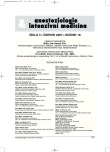Altering the hemodynamics during abdominal aortic aneurysm repair by acute normovolemic hemodilution
Ovlivnění hemodynamiky během operací aneurysmat abdominální aorty užitím metody akutní normovolemické hemodiluce
Cíl studie:
Ověření hypotézy: nemocní operovaní pro aneurysma břišní aorty (AAA) při použití akutní normovolemické hemodiluce (ANH) budou lépe tolerovat naložení a odstranění svorky z aorty, perioperační změny hemodynamických parametrů budou menší a tím klesne frekvence ischemických příhod a komplikací během operace oproti skupině nemocných bez ANH.
Typ studie:
Prospektivní, v jednom centru.
Název a sídlo pracoviště:
Klinika anesteziologie, resuscitace a intenzivní medicíny univerzitní nemocnice.
Materiál a metodika:
Nemocní operovaní pro AAA – skupina A: s ANH (n = 25), skupina B bez ANH (n = 25). U obou skupin byly sledovány hemodynamické parametry (TKsyst,TKdiast, MAP, HR, SV, CO, CI, TSVR – přístroj HemoSonicTM100, počet měření n = 400), stanovena hladina troponinu I, 30denní mortalita, frekvence komplikací. Statistické zpracování: Wilcoxonův pořadový test, Mann-Whitneyho U test, Fisherův přesný test.
Výsledky:
Po zasvorkování aorty došlo ke statisticky významnému vzestupu TKsyst,TSVR, poklesu SV, CO, CI u obou skupin s ANH a bez ANH (p < 0,05). Po odstranění svorky z aorty byl prokázán statisticky významný pokles TSVR, TKsyst, TKdiast, MAP a vzestup SV, CO, CI u obou skupin (p < 0,05). Statisticky významný rozdíl mezi oběma skupinami – s ANH a bez ANH byl pouze v několika parametrech: CI po zasvorkování aorty a TKsyst a MAP před uvolněním svorky z aorty. Nekrózy myokardu: 6krát s ANH vs 8krát bez ANH; statisticky významný rozdíl nebyl prokázán.
Závěr:
Nebyl zjištěn statisticky významný rozdíl ve frekvenci peroperačních a pooperačních komplikací, ischemických příhod a změnách hemodynamických parametrů (kromě několika hodnot) během operací AAA mezi skupinou s ANH a bez ANH.
Klíčová slova:
aneurysma abdominální aorty – akutní normovolemická hemodiluce – hemodynamické parametry – transezofageální dopplerometrie – troponin I
Authors:
J. Mannová 1; Z. Šilhart 2; P. Ševčík 1
Authors‘ workplace:
Klinika anesteziologie, resuscitace a intenzivní medicíny MU v Brně a Fakultní nemocnice Brno
1; Chirurgická klinika MU v Brně a Fakultní nemocnice Brno
2
Published in:
Anest. intenziv. Med., 18, 2007, č. 3, s. 141-149
Category:
Anaesthesiology - Original Paper
Overview
Objective:
To test the hypothesis that patients with acute normovolaemic haemodilution (ANH) tolerate better aortic clamping and declamping during abdominal aortic aneurysm (AAA) repair. Perioperative haemodynamic changes are mitigated, thus the frequency of ischaemic events and cardiovascular complications are decreased in comparison with the group of patients without ANH.
Design:
Prospective randomized study.
Setting:
Department of Anesthesiology, Resuscitation and Intensive Medicine, University Hospital.
Materials and methods:
50 patients admitted for elective AAA repair were prospectively randomized into two groups: patients in group A (n = 25) were treated with ANH and patients in group B (n = 25) were not. We monitored the following parameters: BP, MAP, HR, SV, CO, CI, TSVR (HemoSonicTM100, 400 measurements), troponin I level, transfusion requirements and 30-day mortality. Statistical analysis was made using Wilcoxon’s rank sum test, Mann-Whitney test and Fisher test.
Results:
After aortic clamping a statistically significant increase in the systolic BP and TSVR, and a decrease in SV, CO and CI occurred in both groups (p < 0.05). After aortic declamping, a statistically significant decrease in TSVR and the systolic, diastolic and mean BP, and an increase in SV, CO, CI were seen in both groups (p < 0.05). A statistically significant difference between the two groups was evident in CI after aortic clamping and the systolic and mean BP before declamping. Ischaemic myocardial injury was seen 6 times in patients with ANH vs. 8 times in patients without ANH. A statistically significant difference was not manifested.
Conclusion:
We did not demonstrate a statistically significant difference in haemodynamic changes, the frequency of perioperative or postoperative complications, and ischaemic events between two groups of patients treated with and without ANH.
Key words:
abdominal aortic aneurysm – acute normovolaemic haemodilution – haemodynamic parameters – transesophageal doppler – troponin I
Labels
Anaesthesiology, Resuscitation and Inten Intensive Care MedicineArticle was published in
Anaesthesiology and Intensive Care Medicine

2007 Issue 3
Most read in this issue
- Helium and its role in current medicine
- The evolution of airway management
- Altering the hemodynamics during abdominal aortic aneurysm repair by acute normovolemic hemodilution
- Early resuscitation of septic shock to different levels of arterial blood pressure
